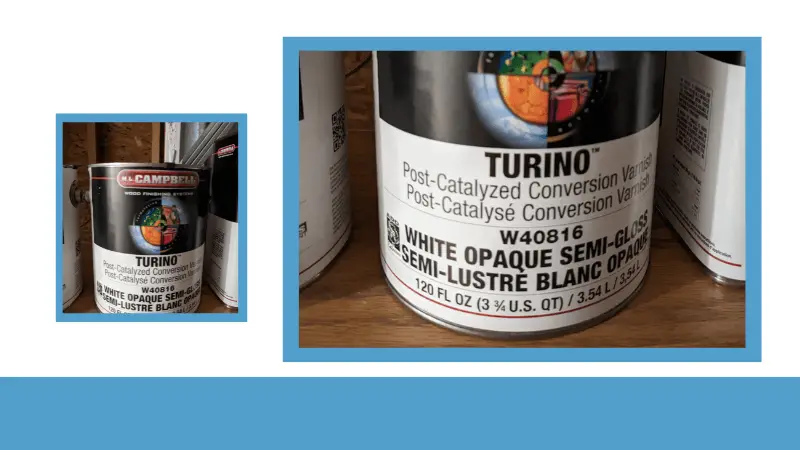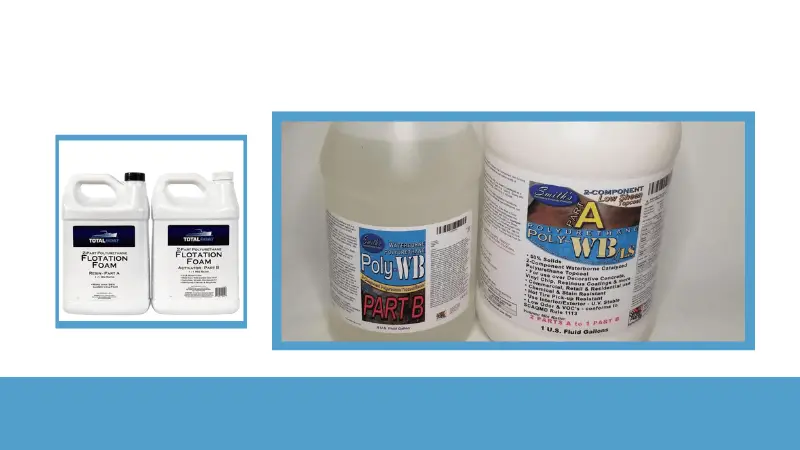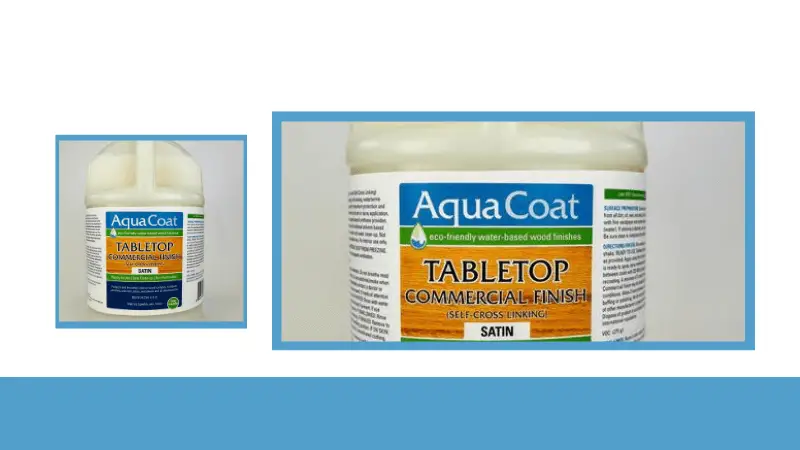In the world of wood finishes, two significant trends have emerged in recent decades. One is the increasing popularity of water-based finishes, while the other is the rise of high-solids, high-performance finishes known as two-part finishes. This article aims to explore these trends, their commonalities, their differences, and the specific characteristics of two-part finishes. We will focus on catalyzed finishes and two-part polyurethane, providing an in-depth understanding of their composition, advantages, limitations, and application techniques.
Water-Based Finishes and Two-Part Finishes
Water-based finishes and two-part finishes share a common attribute—they contain lower levels of solvents compared to other finishes, helping to comply with stringent VOC (Volatile Organic Compounds) regulations aimed at reducing solvent emissions. However, these two types of finishes have been received differently by users. Water-based finishes have encountered resistance due to issues associated with water content, whereas two-part finishes have gained significant traction, primarily because they offer a finish that is exceptionally durable, almost on par with plastic laminate.
Two-part finishes are widely utilized in various industries such as office furniture, kitchen cabinetry, and smaller professional shops. They provide durability, making them a preferred choice for applications that require robust and long-lasting finishes. To ensure the quality and durability of two-part finishes, industry standards, such as the Kitchen Cabinet Manufacturer’s Association (KCMA) Testing Standards, are employed to evaluate the adequacy of the finish and the application process.
The Best-Known Two-Part Finishes
Several well-known two-part finishes dominate the industry, each with its own unique properties and applications. These finishes include:
- Catalyzed finishes: Conversion varnish, post-catalyzed lacquer, and pre-catalyzed lacquer.
- Two-part polyurethane.
- Crosslinking water-based finish.
- Epoxy resin.
Other finishes, such as polyester, ultraviolet-cured (UV) finishes, and powder coatings, also fall under the two-part category but are beyond the scope of this article.
Catalyzed Finishes
Catalyzed finishes have been in use since the 1950s and gained popularity in Europe before making their mark in the United States. They are commonly found on office and institutional furniture, as well as manufactured kitchen and bathroom cabinets. These finishes dry quickly and offer better protection and durability than oil-based polyurethane. Among two-part finishes, catalyzed finishes are the most widely employed.

Composition
Catalyzed finishes are composed of alkyd and amino resins, including melamine formaldehyde and urea formaldehyde. When an acid catalyst is added to these resin combinations, they cure to form a hard film.
There are three main types of catalyzed finishes:
- Conversion varnish: The most protective and durable, it thins with xylene, toluene, or a similar blend specified by the manufacturer. (See Spraying conversion varnish)
- Post-catalyzed lacquer: Contains nitrocellulose lacquer, which speeds up initial drying and enhances repairability, but slightly compromises the resulting film’s strength. It thins with lacquer thinner.
- Pre-catalyzed lacquer: The acid catalyst is added by the manufacturer, allowing for single-container packaging. It resembles nitrocellulose lacquer and thins with lacquer thinner. Although less protective than post-catalyzed lacquer, it offers superior durability compared to nitrocellulose lacquer.
Pros of Catalyzed Finishes
- Excellent heat, wear, solvent, acid, and alkali resistance: Catalyzed finishes offer exceptional durability and protection against various types of damage.
- Excellent water and water-vapor resistance: These finishes are highly resistant to water and moisture, making them suitable for use in kitchens, bathrooms, and other environments with high humidity.
- Very fast curing: Catalyzed finishes dry rapidly, allowing for quicker completion of projects and reducing the waiting time between coats.
- Reduced solvent emissions: Compared to many other finishes, catalyzed finishes contain less solvent, helping to comply with stricter VOC (volatile organic compound) regulations and reduce environmental impact.
Cons of Catalyzed Finishes:
- Hazardous chemicals and fumes: Catalyzed finishes contain toxic substances, such as formaldehyde, which can be hazardous to health. Proper safety measures, including working in a well-ventilated area or wearing protective equipment, are necessary.
- Difficult to incorporate decorative coloring steps: Catalyzed finishes may present challenges when it comes to adding decorative elements like colors, stains, or glazes. Achieving consistent and desired results with coloring can be more challenging than with other finishes.
- Difficult to produce invisible repairs: Repairing catalyzed finishes can be challenging, as achieving seamless and invisible repairs is difficult due to the nature of the finish. Matching the appearance and characteristics of the original finish can be a complex task.
- Difficult to strip: Removing or stripping catalyzed finishes can be laborious and time-consuming. Abrading or sanding is often the only effective method to remove these finishes, which can be a tedious process
Two-Part Polyurethane
Two-part polyurethane finishes have gained popularity in the realm of wood coatings due to their exceptional durability and versatility. These finishes consist of two components—a resin and a hardener—that must be mixed together before application. Two-part polyurethane finishes provide a superior level of protection and are commonly used in high-traffic areas that require robust coatings, such as floors, tabletops, and outdoor furniture.

Composition:
Two-part polyurethane finishes are formulated using a combination of polyols and isocyanates. Polyols are a type of polymer derived from the reaction of an alcohol with multiple hydroxyl groups and are typically made from polyester or polyether. Isocyanates are highly reactive compounds that contain the functional group NCO (isocyanate group). The most common isocyanate used in polyurethane finishes is diisocyanate, which reacts with the polyol to form a strong cross-linked network.
Advantages of Two-Part Polyurethane:
- Exceptional durability: Two-part polyurethane finishes offer excellent resistance to wear, scratches, chemicals, and moisture. They provide a durable protective layer that can withstand heavy use and harsh conditions.
- High-gloss and clarity: These finishes often provide a glossy and clear appearance, enhancing the natural beauty of the wood. They can produce a smooth and flawless surface that showcases the wood’s grain and color.
- UV resistance: Two-part polyurethane finishes typically have good resistance to ultraviolet (UV) light, which helps prevent color fading and wood discoloration caused by prolonged sun exposure. This makes them suitable for both indoor and outdoor applications.
- Fast curing: Once the resin and hardener are mixed, two-part polyurethane finishes cure relatively quickly, reducing the waiting time between coats and allowing for faster project completion.
- Chemical resistance: These finishes exhibit excellent resistance to solvents, acids, alkalis, and household chemicals. They can withstand spills and chemical exposure without staining or damage, making them ideal for kitchen and bathroom surfaces.
Disadvantages of Two-Part Polyurethane:
- Potentially hazardous chemicals: Two-part polyurethane finishes contain isocyanates, which can be hazardous to health if not handled properly. These chemicals can cause respiratory irritation and sensitization. Appropriate safety precautions, such as wearing protective gear and working in a well-ventilated area, are essential when using these finishes.
- Complexity of application: Applying two-part polyurethane finishes requires precise mixing ratios and careful application techniques. Inaccurate mixing or improper application can result in an uneven finish, bubbles, or other imperfections.
- Difficult repairs: Repairing two-part polyurethane finishes can be challenging. Achieving seamless and invisible repairs is difficult due to the strong cross-linking nature of the finish. Matching the original appearance and characteristics of the finish can be a complex task.
- Difficult to strip: Removing or stripping two-part polyurethane finishes can be a laborious and time-consuming process. Mechanical methods such as sanding or abrasive stripping are often necessary, which can be tedious, especially for intricate or curved surfaces.
- Limited decorative options: Two-part polyurethane finishes may not be the best choice for incorporating decorative elements such as colors, stains, or glazes. Achieving consistent and desired results with coloring can be more challenging compared to other types of finishes.
Despite these challenges, two-part polyurethane finishes remain a popular choice for those seeking durable and long-lasting coatings that provide excellent protection for wood surfaces.
Crosslinking Water-Based Finish
Crosslinking water-based finishes have emerged as a popular alternative to traditional solvent-based finishes due to their low VOC (volatile organic compound) content and environmental friendliness. These finishes utilize advanced polymer technology to create a strong cross-linked network within the coating, resulting in enhanced durability and performance. They are commonly used in various applications, including furniture, cabinetry, and flooring.

Composition:
Crosslinking water-based finishes are formulated using a combination of water-based polymers and crosslinking agents. The water-based polymers are typically acrylic or polyurethane-based and provide the primary film-forming properties. The crosslinking agents, such as melamine, isocyanates, or aziridines, are added to promote the formation of chemical bonds between the polymer chains, resulting in a robust cross-linked structure.
Advantages of Crosslinking Water-Based Finishes:
- Low VOC content: Crosslinking water-based finishes have significantly lower VOC emissions compared to traditional solvent-based finishes. This makes them more environmentally friendly and safer to use in indoor settings, as they contribute less to air pollution and minimize health risks for both users and occupants.
- Exceptional durability: The crosslinking process in these finishes enhances their durability, providing resistance to wear, scratches, chemicals, and moisture. They offer a protective layer that can withstand daily use and exposure to various household and commercial environments.
- Fast curing: Crosslinking water-based finishes typically cure relatively quickly, allowing for faster project completion. They dry to touch within a short period, reducing waiting time between coats and enabling efficient workflow.
- Excellent clarity and color retention: These finishes often exhibit excellent clarity, allowing the natural beauty of the wood to shine through. They provide a clear, glossy finish that enhances the wood’s grain and color. Additionally, crosslinking water-based finishes offer superior resistance to yellowing, ensuring long-term color retention.
- Easy clean-up and low odor: Since these finishes are water-based, they can be easily cleaned up with water, reducing the need for harsh solvents or chemicals. They also emit lower levels of odor during application, creating a more pleasant working environment.
Disadvantages of Crosslinking Water-Based Finishes:
- Complexity of application: Crosslinking water-based finishes require careful attention to mixing ratios and proper application techniques. Improper mixing or application can result in uneven coverage, streaks, or other visual imperfections. Following the manufacturer’s guidelines and practicing good application techniques is crucial to achieve optimal results.
- Limited open time: These finishes often have a limited open time, meaning they dry quickly once applied. This can make it challenging to achieve seamless blending or correction of mistakes during application. Proper planning and efficient work techniques are necessary to ensure a smooth and consistent finish.
- Sensitivity to temperature and humidity: Crosslinking water-based finishes can be sensitive to temperature and humidity conditions during application and curing. Extreme temperatures or high humidity levels may affect the drying and curing process, potentially leading to suboptimal results. It is essential to follow the manufacturer’s recommendations regarding temperature and humidity conditions for best performance.
- Difficult repairs: Repairing crosslinking water-based finishes can be challenging due to their strong cross-linked structure. Achieving invisible repairs or seamlessly blending touched-up areas can be difficult, and color matching may pose a significant challenge.
- Limited compatibility with other finishes: Crosslinking water-based finishes may not be fully compatible with certain solvent-based finishes or coatings. When considering recoating or topcoating with a different product, compatibility testing and thorough surface preparation are recommended to ensure proper adhesion and performance.
Despite these challenges, crosslinking water-based finishes offer a compelling option for those seeking a durable, environmentally friendly, and low VOC coating
Epoxy Resin
Epoxy resin is a versatile and widely used material known for its exceptional strength, durability, and adhesive properties. It is a thermosetting polymer that forms a hard, rigid, and chemically resistant surface when cured. Epoxy resin finds applications in various industries, including construction, automotive, aerospace, electronics, and crafts.
Composition:
Epoxy resin is a two-component system consisting of a resin and a hardener. The resin is typically a bisphenol A (BPA) or bisphenol F (BPF) epoxy, while the hardener is often a polyamine or polyamide compound. When the resin and hardener are mixed in the correct proportions, a chemical reaction called curing takes place, resulting in a solid, cross-linked structure.
Advantages of Epoxy Resin:
- Exceptional strength and durability: Epoxy resin offers outstanding mechanical properties, including high tensile strength, impact resistance, and toughness. It forms a rigid and durable surface that can withstand heavy loads, making it suitable for demanding applications such as flooring, structural components, and composite materials.
- Chemical resistance: Epoxy resin exhibits excellent resistance to a wide range of chemicals, including acids, solvents, oils, and alkaline substances. This resistance makes it an ideal choice for protective coatings, tank linings, and industrial environments where exposure to corrosive agents is prevalent.
- Adhesive properties: Epoxy resin is renowned for its strong adhesive capabilities. It can bond well with various materials, including metals, plastics, wood, concrete, and fiberglass. This makes it valuable in construction, manufacturing, and repair applications where a reliable and durable bond is required.
- Versatility: Epoxy resin is highly versatile and can be formulated to meet specific application requirements. It can be pigmented, filled with additives, or modified with other resins to enhance specific properties such as flexibility, UV resistance, or flame retardancy. This adaptability makes it suitable for a wide range of applications. (see Best epoxy resin for plywood)
- Excellent electrical insulation: Epoxy resin is an excellent electrical insulator, providing insulation and protection for electronic components, circuit boards, and electrical systems. It offers high dielectric strength, low dielectric loss, and good dimensional stability, ensuring reliable performance in electrical applications.
Disadvantages of Epoxy Resin:
- Potentially hazardous during handling: Epoxy resin typically contains chemicals that can be harmful if mishandled or improperly used. It is important to follow safety precautions, such as wearing protective gloves and working in a well-ventilated area, to minimize the risk of skin irritation or inhalation of fumes during the mixing and application process.
- Long curing time: Epoxy resin generally requires a longer curing time compared to other types of coatings or adhesives. The curing process can take several hours or even days, depending on the formulation and ambient conditions. Proper planning and patience are necessary to allow for adequate curing before subjecting the material to stress or use.
- UV sensitivity: Epoxy resin is prone to yellowing and degradation when exposed to prolonged sunlight or UV radiation. This makes it less suitable for outdoor applications or areas with extensive UV exposure. However, certain epoxy formulations are available with enhanced UV resistance for outdoor use.
- Surface preparation requirements: Epoxy resin requires thorough surface preparation to ensure proper adhesion and performance. The surface must be clean, dry, and free from contaminants or previous coatings. Abrasion or sanding is often necessary to create a suitable surface profile for optimal bonding.
- Not easily reversible: Once cured, epoxy resin is difficult to remove or reverse. Repairing or removing epoxy-coated surfaces can be challenging and may require abrasive methods or specialized solvents.